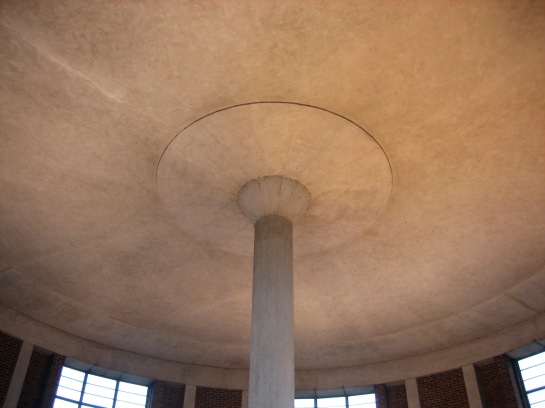50. The interior of Arnos Grove
 Before I moved to London, the most exposure I’d had to Arnos Grove came from its appearance in Saint Etienne’s glorious song from 1991, Girl VII.
Before I moved to London, the most exposure I’d had to Arnos Grove came from its appearance in Saint Etienne’s glorious song from 1991, Girl VII.
Here, the station is namechecked as part of a dazzling roll-call of locations both provincial and exotic, which (quite rightly) elevates the likes of Dollis Hill and Chalk Farm to equal status with San Clemente and Bratislava. And all to a disco beat.
Like almost everything Saint Etienne have ever done, Girl VII gets under your skin and is impossible to resist – two qualities also true of Arnos Grove itself.
 Garlanded and canonised like no other Underground station, Arnos Grove still defies even your highest of expectations. Moreover, it seems to be able to do it again and again. Every time I visit, there’s some aspect of the architecture or sensation created by the light and the shadows that affects me in a different way. It never lets you down. I’m not sure anywhere else on the London Underground can do this.
Garlanded and canonised like no other Underground station, Arnos Grove still defies even your highest of expectations. Moreover, it seems to be able to do it again and again. Every time I visit, there’s some aspect of the architecture or sensation created by the light and the shadows that affects me in a different way. It never lets you down. I’m not sure anywhere else on the London Underground can do this.
The interior wears its heritage and its awards with pride. But it deserves to. This is a very special place, which – unlike other works of popular culture that top critics’ polls with the charmless thud of Del Boy falling through a bar – utterly warrants its lauded reputation. Perhaps this is due to the notional incongruity of an Underground station being also a piece of art, though countries such as Germany and Sweden, from where Charles Holden took inspiration for the building’s appearance, surely would not consider such a relationship incongruous at all.
 Holden’s approach to the design of Underground stations reaches its zenith with Arnos Grove. The function of the building enjoys a marriage with style that is the happiest of any such union across the whole network.
Holden’s approach to the design of Underground stations reaches its zenith with Arnos Grove. The function of the building enjoys a marriage with style that is the happiest of any such union across the whole network.
The enormous drum and central passimeter that together form the basis of the interior act as both an instruction, making plain exactly where you need to go for tickets, telephones and trains; and also as an illumination, rendering the purpose of the station elegantly self-evident while literally casting or reflecting light upon everybody and everything inside.
A vision burns brightly in this outpost of artistry high in the suburbs of north London. It’s one that doesn’t simply impress; it shepherds and reassures and becalms. No wonder one appraisal of the station ranked it on a par with the likes of the Pompidou Centre and the Sydney Opera House.
Another, more official evaluation upgraded Arnos Grove to Grade II* listed status in July 2011. The man who approved this, John Penrose, was sacked by David Cameron in the cabinet reshuffle of September 2012.
 Like Ulysses by James Joyce, Arnos Grove is a modernist classic. Unlike Ulysses, Arnos Grove is something you will enjoy finding your way in and out of, and to which you will want to return again and again.
Like Ulysses by James Joyce, Arnos Grove is a modernist classic. Unlike Ulysses, Arnos Grove is something you will enjoy finding your way in and out of, and to which you will want to return again and again.
As for the station’s exterior… that deserves a separate entry all to itself.

Those telephone cabinets look identical to the ones that used to be in Ravenscourt Park station as late as 1988. After moving away from the area, I was shocked when I returned a decade later, that somebody had seen fit to remove them. They were the only period feature in an otherwise unremarkable building, so it is not a surprise that it was never considered for listing.